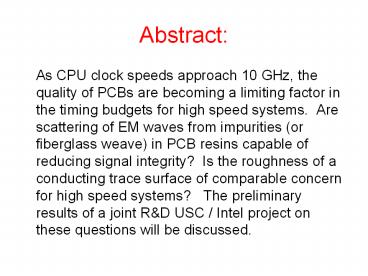Abstract: - PowerPoint PPT Presentation
1 / 42
Title:
Abstract:
Description:
Abstract: As CPU clock speeds approach 10 GHz, the quality of PCBs are becoming a limiting factor in the timing budgets for high speed systems. – PowerPoint PPT presentation
Number of Views:52
Avg rating:3.0/5.0
Title: Abstract:
1
Abstract
- As CPU clock speeds approach 10 GHz, the quality
of PCBs are becoming a limiting factor in the
timing budgets for high speed systems. Are
scattering of EM waves from impurities (or
fiberglass weave) in PCB resins capable of
reducing signal integrity? Is the roughness of a
conducting trace surface of comparable concern
for high speed systems? The preliminary results
of a joint RD USC / Intel project on these
questions will be discussed.
2
Signal Scattering from Impurities in PCBsPaul G.
Huray University of South Carolina
- First ITESO-Intel International Workshop on
Signal Integrity1200 1230 AM, April 7, 2005
Guadalajara, México
3
Talk Outline
- Who is participating in the project?
- Importance of the project.
- TDR tool development.
- Preliminary Results.
- Analytic Scattering Theory.
- Numerical Scattering Outcomes.
- Future Directions.
4
ParticipantsIndustry Academia
- Intel
- Richard Mellitz, Columbia, SC
- Paul Hamilton, Hillsboro, OR
- Jim McCall, Hillsboro, OR
- Janjie Zhu, DuPont, WA
- University of South Carolina
- Paul G. Huray, Professor
- Yinchao Chen, Assoc. Prof.
- Peng Ye, PhD candidate
Femi Oluwafemi, DuPont, WA
5
Importance of the project
- Silicon density approximately doubles every 18
months (Moores law). - PWB electrical technology improvement is much
slower. - PWBs have afforded excess electrical capability
since the 1970s. - Now, GHz signal presents new signaling challenges
for PWB. - PWB properties could throttle system speed
improvements.
6
(No Transcript)
7
PCB Manufacture
- PCBs are made from dielectrics that have been
clad with copper foil. - They are available in different materials and
thicknesses - FR4 (Flame Retardant e4) is a glass fiber epoxy
laminate
8
Glass Cloth Samples
1080 glass
2116 glass
7628 glass
9
Copper Surface Roughness
10
Can we develop a sensitive, simple TDR Tool for
Manufacturers?
- Should be a simpler method than a VNA.
- It is sensitive enough to show differences in
board and copper types? - Can PWB manufacturers use the tool for
performance analysis?
11
Pulse Application and Measurement of Transmitted
Energy
50-ohm resistive Splitter / combiner
TDR heads on extension cables
1250 micron Cascade probes
12
Analysis Options
Pulse Height
Pulse Width Pulse Height
Pulse Width _at_ 50
Area
13
PRELIMINARY RESULTS Peak Analysis
14
PRELIMINARY RESULTS Shape Analysis
Input pulse
Output pulses
15
PRELIMINARY RESULTS Sensitivity Analysis
Differentiates di-electric material and rough vs
smooth copper.
16
PRELIMINARY RESULTS pulse amplitude response
tracks S21
Conclusion Normal TDR with superposition can
measure PWB line loss
17
PRELIMINARY Derivative Peak Analysis
18
Analytic Theory Steps
- An external pulse at z0 on a microstrip
waveguide leads to a Magnetic Vector Potential,
, in a volume of homogeneous FR4 that
can be calculated by Greens Theorem. - The Magnetic Vector Potential yields TEMz
electric field intensity, Einc, and magnetic
field intensity, Hinc, in homogeneous FR4. - An inclusion (bubble or fiberglass cylinder) in
FR4 provides a scattering center for incident
Einc and Hinc fields. - A conducting hemisphere on the surface of a
microstrip trace provides another type of
scattering center for incident fields. - Scattered fields lead to a redistribution of the
current density in the microstrip trace and in
the ground plane. - Use multiple scattering centers of various radii
(absence of FR4, conducting hemispheres) to
model manufactured PWB traces with statistical
distribution of bubbles, fiberglass cylinders and
rough surfaces.
19
Dimensions
20
Variables of FR4 inclusion model
21
Orthogonal View of inclusion Model
22
Variables of surface hemisphere
23
Orthogonal View of surface hemisphere
24
Orthogonal View of inclusion Model
25
Step 1 Calculate Az(x,t)
26
Step 2 Calculate Einc(x,t) and Hinc (x,t)
27
Step 3 Calculate Esc(x,t) from a spherical
inclusion
Center is a sphere of radius a that produces
absence of FR4. Center may absorb and scatter
external fields. Fields are outgoing waves at
infinity that may be expanded as
28
Scattering Parameters
- Coefficients a(l) and ß(l) are determined by
the boundary conditions at ra. - If the spherical surface impedance is Zs,
- EtanZs aRxH and
29
Cross Sections
30
Step 4 Calculate Hsc(x,t) from a spherical
scattering center
- Equations are the same as Step 3 with Boundary
Conditions at ra
31
Step 5 Calculate Jz(x,t) due to scattering from
centers
- Scattered fields lead to a redistribution of the
current density in the microstrip trace and in
the ground plane. - For the microstrip
32
Step 6 Calculate for Multiple scattering centers
- Evaluate Jz(x,t) for a variety of scattering
radii (volume bubbles and surface hemispheres) - Evaluate the effect of off-center spheres
- Evaluate the effect of a random distribution of
volume bubbles and surface hemispheres
33
Initial Numerical CFDTD with PCB impurities
34
Time domain field distribution
35
Time domain current distribution
36
Initial CFDTD model with PCB impurity
37
Time domain field distribution
38
Time Domain current distribution
39
Comparison of field distributions
40
Comparison of current distributions
41
Comparison of field distributions
Without impurity
With air bubble
42
Comparison of field distributions
With dielectric bubble er10
With PEC bubble
43
Compare model predictions, numerical outcomes
with measured output
- Validate model by comparing measured outputs and
numerical outcomes with manufactured spherical
inclusion samples. - Validate the model by comparing measured outputs
and numerical outcomes with manufactured rough
surface samples. - Refine the model to compensate for irregular
shaped inclusions or trace surface features.
44
Customize TDR input pulses for differential
measurements
- Determine if a choice of input pulses can
differentiate scattering from volume sphere
inclusions and surface conducting hemispheres. - Plan regimen of input pulses for unknown samples
to measure distribution of FR4 inclusions and
microstrip trace roughness.































